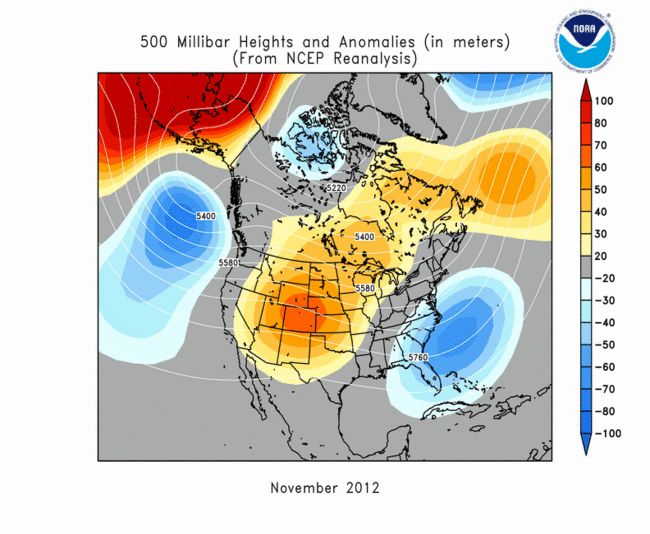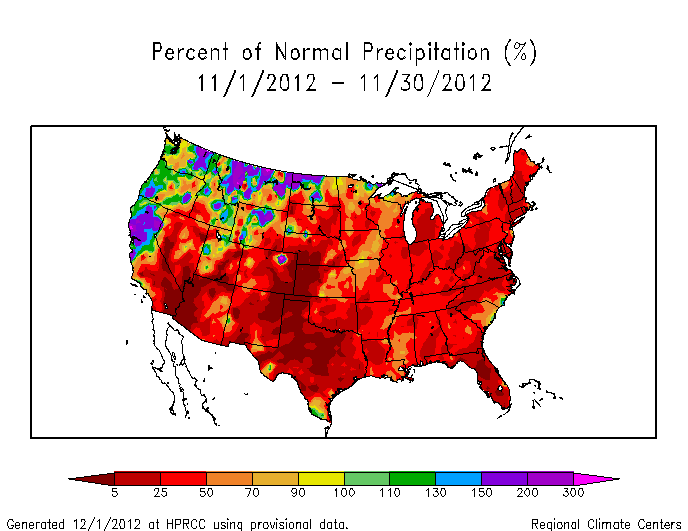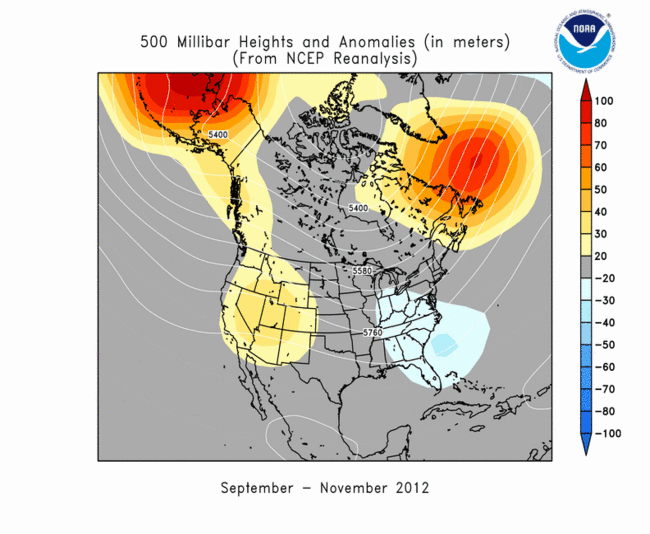Note: This Synoptic Discussion describes recent weather events and climate anomalies in relation to the phenomena that cause the weather. These phenomena include the jet stream, fronts and low pressure systems that bring precipitation, high pressure systems that bring dry weather, and the mechanisms which control these features — such as El Niño, La Niña, and other oceanic and atmospheric drivers (PNA, NAO, AO, and others). The report may contain more technical language than other components of the State of the Climate series.
Synoptic Discussion
The weather pattern this time of year normally consists of the seasonal battle between subtropical high pressure (High, or upper-level ridge) to the south and the polar jet stream and associated storm track to the north. As the sun angle decreases during Northern Hemisphere autumn and early winter, polar air masses get colder and expand the polar jet toward the south. During November 2012, several weather systems moved through the jet stream's 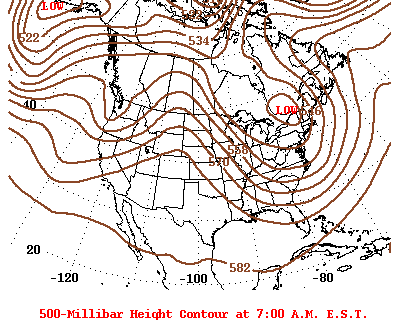 westerly circulation over the United States, bringing above-normal precipitation to the northwestern parts of the country. But
westerly circulation over the United States, bringing above-normal precipitation to the northwestern parts of the country. But  upper-level high pressure, centered over the Southwest to central Rockies, fought back, setting up a pattern which mostly kept moisture away from the central and eastern regions and much of the Southwest.
upper-level high pressure, centered over the Southwest to central Rockies, fought back, setting up a pattern which mostly kept moisture away from the central and eastern regions and much of the Southwest. 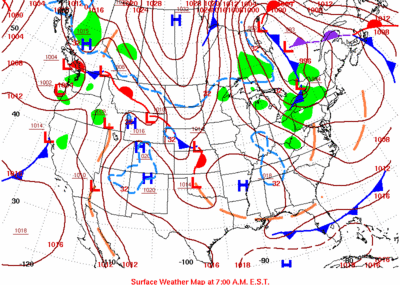 Cold fronts sweeping across the Plains and into the South and East brought below-normal monthly temperatures to much of the country east of the Mississippi River, while the upper-level ridge kept temperatures warmer than normal across much of the West for most of the month. This weather pattern inhibited the formation of tornadoes, reduced the coverage of snow, and expanded the area and intensity of drought.
Cold fronts sweeping across the Plains and into the South and East brought below-normal monthly temperatures to much of the country east of the Mississippi River, while the upper-level ridge kept temperatures warmer than normal across much of the West for most of the month. This weather pattern inhibited the formation of tornadoes, reduced the coverage of snow, and expanded the area and intensity of drought.
The movement of the weather systems can be seen in the weekly precipitation anomaly patterns (weeks 1, 2, 3, 4). Frontal precipitation occurred in the West and Plains early in the month, and in the Midwest and Southeast at mid-month; but, otherwise, most of the country outside of the northwestern regions saw little precipitation. Western storms expanded snow coverage to about a third of the country by November 12th, but the snow cover rapidly contracted. All told, monthly snow cover and snow water equivalent were below average. Twenty-two states ranked in the top ten driest category for November, with another 18 ranking in the driest third of the historical record. Only Montana, North Dakota, and Oregon were in the wettest third of the historical record. With all of the dry weather, drought expanded this month. According to the end-of-November (November 27) U.S. Drought Monitor, 62.7% of the contiguous U.S. (52.4% of the U.S. including Alaska, Hawaii, and Puerto Rico) was affected by moderate to exceptional drought overall. According to the Palmer Drought Index, which goes back to the beginning of the 20th century, 59.5% of the contiguous U.S. was in moderate to extreme drought, an increase of about 7% compared to last month. The 2012 Palmer Drought Index percent area values have been exceeded only by the drought of the 1930s.
The weekly temperature anomaly maps (weeks 1, 2, 3, 4) show the dominance of cooler air masses at mid-month and in the east early in the month, as well as the expansion of the ridge and warmer air masses later in the month as the jet stream retreated to the north. Five states ranked in the top ten warmest category for November, all in the West, while another 13 western, Great Plains, and Midwest states ranked in the warmest third of the historical record. At the opposite extreme, North Carolina ranked in the top ten coldest category with 17 other states (all east of the Mississippi River) falling in the coldest third of the historical record. On a local basis, almost three times as many record warm highs and lows occurred than record cold highs and lows. About 1800 daily high temperature records and 1300 record warm daily low temperatures were tied or broken. In comparison, about 450 record low temperatures and 600 record cool daily high temperatures were tied or broken. (These numbers are preliminary and are expected to increase as more data arrive.) On balance, the warm and cold anomalies, combined with the time of year, contributed to a national Residential Energy Demand Temperature Index (REDTI) for November 2012 that was near average.
When averaged together, the mixture of temperature and precipitation extremes gave the U.S. the 20th warmest and eighth driest November in the 118-year record. Averaging extremes tends to cancel them out. But when extremes are combined cumulatively, like in the U.S. Climate Extremes Index (USCEI), they may tell a different story. Nationally, the large spatial extent of very dry conditions (third largest PDSI component for November 2012, behind November 1954 and 1934, and 18th largest number of days without rain component), the heavy precipitation in the Far West (14th largest extremes in 1-day precipitation component), and the large spatial extent of very warm maximum (11th largest) and minimum (22nd largest) temperatures combined to give the U.S. a November USCEI that was 11th largest. The preponderance of unusual warmth and dryness for much of 2012 has ranked the national USCEI largest for the year-to-date (January-November) and last twelve months (December-November) and eighth largest for the last six months (June-November).
Subtropical highs, and cold fronts and low pressure systems moving in the storm track flow, are influenced by the broadscale atmospheric circulation. Five such large-scale atmospheric circulation drivers were potentially influential during November:
-
El Niño Southern Oscillation (ENSO)
- Status: Ocean temperatures and atmospheric circulation anomalies indicated that the equatorial Pacific continued in an ENSO-neutral state during November, although equatorial sea surface temperatures (SSTs) remained above average across much of the Pacific Ocean except for below-average SSTs in the far eastern equatorial Pacific.
- Teleconnections (influence on weather): To the extent teleconnections are known, while in a neutral state, ENSO normally is not a player in the month's weather. Historical data can be analyzed to show typical temperature and precipitation patterns associated with the ENSO episodes. For an El Niño, the typical September-November temperature anomaly pattern is below-normal temperatures for the Southwest and patchy below-normal temperatures from the Southern Plains and Southeast to Midwest, with patchy above-normal temperatures for the Northwest. The typical El Niño September-November precipitation anomaly pattern consists of drier-than-normal conditions in the mid-Atlantic to Northeast, much of the Great Lakes, and parts of the Ohio Valley and Central Plains. Wetter-than-normal conditions usually occur in the Tennessee Valley to Southern Appalachians, with patchy wet conditions in the Great Plains and West. For a La Niña, the typical September-November temperature anomaly pattern consists of warmer-than-normal conditions from the Central Plains to the Great Lakes, and precipitation anomaly pattern is drier than normal across much of the country from the Southwest to Northeast, and all along the Mississippi River Valley, with above-normal precipitation mostly along the Northwest coast.
- Observed: The November and September-November 2012 precipitation patterns match the La Niña teleconnections for much of the country from the West Coast to Mississippi Valley and parts of the Southeast and Northeast; the September-November patterns show some hint of correlation to El Niño's in the Tennessee Valley to mid-Appalachians, but not elsewhere. The November and September-November 2012 temperature patterns agree with El Niño for the Southeast, but not elsewhere, and don't agree with the La Niña teleconnections.
- The Pacific/North American (PNA) pattern
- Status: The PNA index was near zero at the beginning of the month then trended negative for the rest of November.
- Teleconnections (influence on weather): To the extent teleconnections are known, the temperature teleconnection map for this time of year (October on the maps) shows that a negative PNA is correlated with warmer-than-normal temperatures in the Southeast and cooler-than-normal temperatures along the west coast of North America, especially in western Canada and Alaska. The precipitation patterns are weakly correlated this time of year, but show some hint of wetter-than-normal conditions from the Ohio Valley to Great Lakes with a negative PNA.
- Observed: November 2012 was wetter than normal in the Northwest and drier than normal across the rest of the country, which bears little resemblance to the pattern expected with a negative PNA. The month was generally cooler than normal east of the Mississippi River and warmer than normal west of it, with cooler than normal temperatures across Alaska. The Alaska temperature pattern is consistent with that expected from a negative PNA, but the contiguous U.S. pattern more closely resembles that for a positive PNA than negative PNA.
- The Arctic Oscillation (AO) pattern
- Status: The AO index began the month negative, transitioned rapidly into positive territory, then ended the month negative again.
- Teleconnections (influence on weather): To the extent teleconnections are known, a negative AO this time of year (September-November) is typically associated with cooler-than-normal temperatures across the Northern Plains, patchy dry conditions in the Northwest, from the Southern Plains to Midwest, and in the Southeast, and patchy wet conditions in southern Florida and parts of the Great Lakes and New England. A positive AO is typically associated with warmer-than-normal temperatures across the Northern and Central Plains to the Great Lakes, dry conditions across much of the country from the Great Plains to the Northeast, and patchy wet conditions in parts of the Northwest and coastal Southeast. The September-November averaged upper-level circulation anomalies for a negative AO are below normal 500-millibar (mb) geopotential heights (which translates to stronger trough or weaker ridge, depending on the circulation) over the northeastern third of the U.S. and above-normal 500-mb heights (which translates to stronger ridge or weaker trough, depending on the circulation) over the Arctic. A positive AO is typically associated with the opposite pattern.
- Observed: The November and September-November 2012 temperature patterns in the Northern Plains to Great Lakes are an area of transition from warmer- to cooler-than-normal conditions, which doesn't match either the negative AO or positive AO teleconnections. However, the September-November 2012 temperature pattern east of the Mississippi more closely resembles what would be expected during the winter with a negative AO. The November and September-November 2012 precipitation patterns have more in common with the positive AO than the negative AO, although there are significant differences in the East. The September-November 2012 upper-level circulation had an above-normal pattern over the northwestern Atlantic, Pacific coast of North America, and western U.S., with a trough (below-normal pattern) over the southeastern United States. This has some resemblance to a negative AO in the eastern U.S. but not in the western U.S., and the Arctic pattern is not a good match.
- The North Atlantic Oscillation (NAO) pattern
- Status: The NAO index started the month negative, transitioned to positive, then hovered near zero but slightly negative for the last half of November.
- Teleconnections (influence on weather): To the extent teleconnections are known, a negative NAO during this time of year (October on the teleconnection maps) is typically associated with drier-than-normal conditions in the Ohio Valley, while a positive NAO is typically wetter than normal there. Temperatures show little correlation.
- Observed: The weak correlations this time of year make it difficult to relate the November and September-November 2012 precipitation and temperature anomaly patterns to the NAO. The temperature pattern in the eastern U.S. more closely resembles what would be expected from a negative NAO in the winter.
- The East Pacific-North Pacific (EP-NP) pattern relates sea surface temperature (SST) and upper-level circulation patterns over the eastern and northern Pacific to temperature, precipitation, and circulation anomalies downstream over North America.
- Status: The SST pattern over the northeast Pacific experienced a warming trend from June to October with SST anomalies becoming less cool (June, July, August) to warmer than normal in places (September, October). The trend reversed itself during November, with the warm SST anomalies becoming less warm and the cool SST anomalies expanding. This has resulted in a weaker, but still positive, EP-NP index (3-month running mean).
- Teleconnections (influence on weather): To the extent teleconnections are known, a positive EP-NP index during this time of year (October on the teleconnection maps) is typically associated with cooler-than-normal temperatures east of the Rockies, warmer-than-normal temperatures along the West Coast and Alaska, drier-than-normal conditions over the Northwest (although the correlations are weak for precipitation), below-normal upper-level circulation anomalies (stronger upper-level trough) over eastern North America, and above-normal upper-level circulation anomalies (stronger upper-level ridge) over western Canada and Alaska. A negative EP-NP index is typically associated with the opposite patterns.
- Observed: The November and September-November 2012 temperature patterns readily reflect the positive EP-NP teleconnection across much of the country east of the Mississippi, but reflect a negative EP-NP in Alaska. The precipitation correlations are weak but, for the Northwest, reflect a negative EP-NP rather than a positive EP-NP. The patterns of upper-level height anomalies for November and September-November do not match the anomaly pattern for a positive EP-NP. The above-normal heights over western Canada and the western U.S. in September-November seem to have shifted eastward during November with below-normal heights appearing over the northeastern Pacific, perhaps associated with the shifting SST anomalies and weakening EP-NP. The below-normal heights over the southeastern U.S. for both November and September-November 2012 are farther to the southeast than they appear in the teleconnection map for a positive EP-NP.
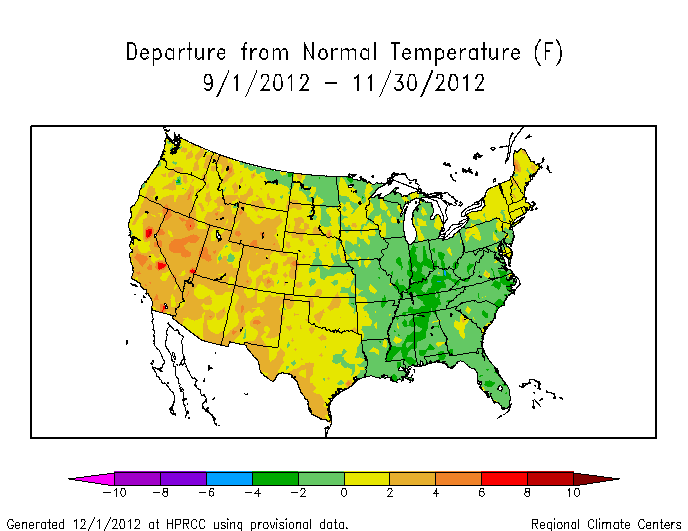 |
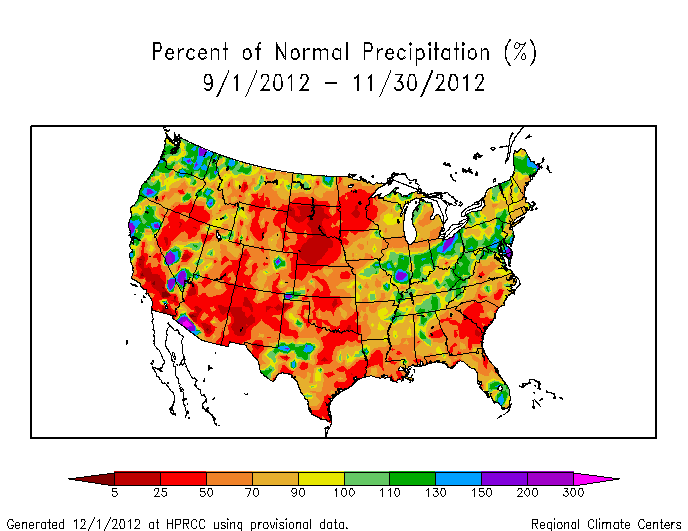 |
Examination of these circulation indices and their teleconnection patterns, and comparison to observed November and September-November 2012 temperature, precipitation, and circulation patterns, suggests that it is difficult to associate the observed weather patterns to any of these indices. The teleconnections are weak this time of year for the PNA and NAO. The tropical Pacific is in a neutral ENSO phase and the AO and EP-NP were in a state of transition during November. When the atmospheric circulation drivers are neutral or in a state of transition, their influence becomes difficult to trace and can be overwhelmed by other competing forces, including random fluctuations in the atmosphere.
 NOAA's National Centers for Environmental Information
NOAA's National Centers for Environmental Information
